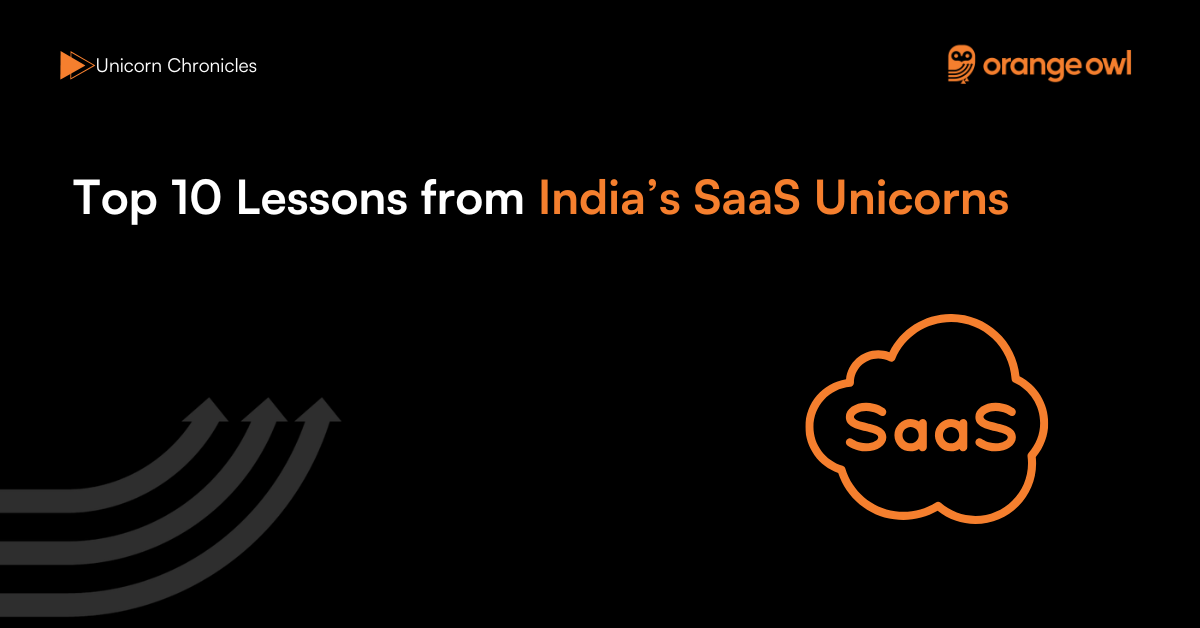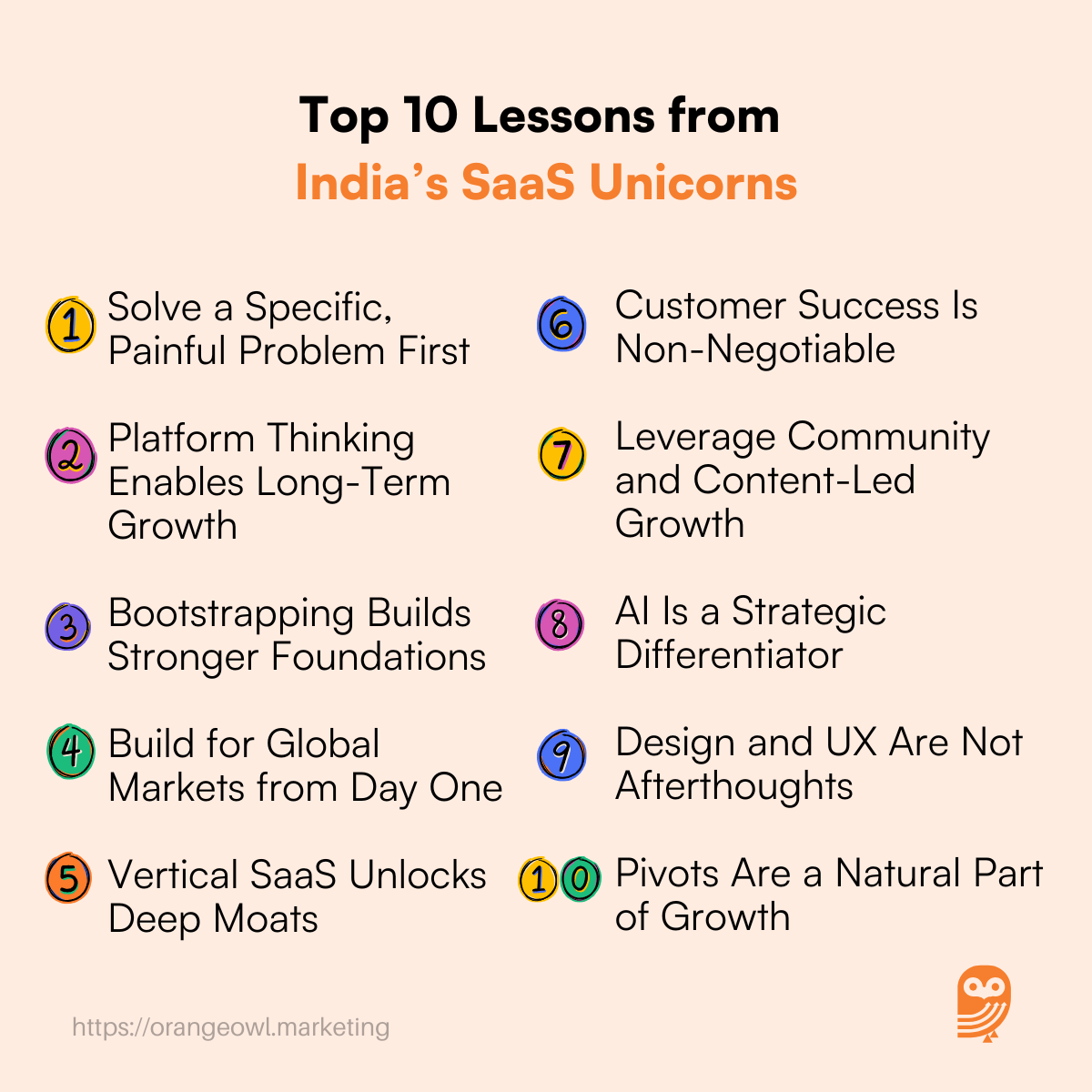Top 10 Lessons from India’s SaaS Unicorns
Vivek Goel
May 26, 2025

Table of Contents
Introduction
India’s Software-as-a-Service (SaaS) sector has experienced a remarkable transformation over the past decade. What was once known primarily as an IT outsourcing destination has now emerged as a hotbed for world-class product innovation. Indian SaaS startups are no longer just supporting international tech firms—they’re building globally admired platforms, selling to Fortune 500 companies, and redefining the enterprise software game from the ground up.
This new wave of innovation is being led by companies that focus on product excellence, global scalability, and customer-centric design. These startups are tackling complex business problems with simplicity and elegance—whether it’s automating HR operations, streamlining customer support, enhancing data security, or optimizing contract management. From humble beginnings in Bengaluru, Chennai, Pune, and Hyderabad, these companies are now competing with the best in Silicon Valley.
To understand the DNA of these trailblazing ventures, we conducted a comprehensive study of 16 Indian SaaS unicorns—companies that have achieved valuations of $1 billion or more. Our research included well-known giants like Freshworks, BrowserStack, as well as fast-growing disruptors like Darwinbox, Zenoti, Druva, Chargebee, and others. We examined their founding stories, product strategies, growth tactics, market positioning, funding journeys, and leadership insights.
Through this deep-dive, we discovered recurring patterns—strategic choices, cultural mindsets, and business principles that set these companies apart and fueled their meteoric rise. Whether you’re a startup founder, product leader, investor, or just passionate about India’s tech evolution, these lessons offer a roadmap to building resilient, high-growth SaaS companies.
📌 You can read the complete company-wise breakdown here:
👉 The Rise of Indian SaaS Unicorns: 16 Powerful Stories Every Entrepreneur Must Read
Based on our study, here are 10 key lessons that every aspiring SaaS founder and leader should take to heart.
1. Solve a Specific, Painful Problem First
All great SaaS businesses begin by obsessing over a single, painful customer problem. Rather than chasing trends or building for scale too early, companies like BrowserStack and Druva started with one mission-critical task.
BrowserStack focused on a challenge developers faced every day—manual, time-consuming browser compatibility testing. By turning it into a simple, cloud-based tool, they gained rapid traction among developers globally. Similarly, Druva saw that enterprises needed reliable, cloud-first data protection as their infrastructure migrated from on-prem to cloud.
This sharp focus helped them build products that were not just useful, but indispensable.
🔍 Example: Druva didn’t try to become a generalized storage provider. It became the go-to solution for cloud-native data backup—earning trust from enterprises like NASA and Marriott.
Lesson: Clarity of problem leads to clarity in solution. Don’t dilute your offering early—solve one pain point better than anyone else.
2. Bootstrapping Builds Stronger Foundations
While VC money can unlock rapid growth, bootstrapping forces entrepreneurs to focus on the fundamentals—building products customers love and will pay for. Companies like Mu Sigma and BrowserStack thrived for years without external capital, allowing them to stay lean, customer-centric, and free from pressure to chase vanity metrics.
Bootstrapped companies often develop a deep understanding of unit economics, product-market fit, and customer retention—before scaling. This resilience pays off when they do eventually decide to raise capital, often on better terms.
🔍 Example: Mu Sigma, a pioneer in decision sciences, grew into a global player serving Fortune 500 clients without VC funding in its early years. The company scaled through sheer focus on customer delivery and value creation.
Lesson: Bootstrapping isn’t just a funding decision—it’s a discipline. It teaches sustainability, customer obsession, and profitability-first thinking.
3. Build for Global Markets from Day One
A defining trait of Indian SaaS unicorns is their global mindset from inception. Instead of building solely for the domestic market, companies like Freshworks, Innovaccer, and Icertis built products targeting customers in the U.S., Europe, and beyond. This mindset gave them access to bigger budgets, more mature SaaS buyers, and faster scaling opportunities.
This global-first strategy often required early investments in international sales teams, localization, and regulatory compliance—but the payoff was substantial.
🔍 Example: Freshworks, headquartered in Chennai, secured its first 100 customers from the U.S. by attending global trade shows and offering competitive alternatives to Zendesk and Salesforce. Its IPO on NASDAQ was a first for an Indian SaaS firm.
Lesson: Think global even if you build local. The SaaS market is borderless, and so should be your ambition.
4. Vertical SaaS Unlocks Deep Moats
Instead of going horizontal and building generic solutions for everyone, many unicorns doubled down on one specific industry—offering deeply tailored solutions that were hard to replicate. Zenoti became a leader in wellness and salon management, while LeadSquared focused on education and BFSI sales enablement. These companies won not just on features but on their nuanced understanding of workflows, compliance needs, and customer pain points.
This specialization also allowed them to command higher ARPU (average revenue per user) and enjoy lower churn due to better product-market fit.
🔍 Example: Zenoti integrated appointment booking, CRM, payments, and inventory into one seamless platform built specifically for spas and salons—making it indispensable for their operations.
Lesson: If you know an industry deeply, build for it. Vertical SaaS often has less competition, stronger retention, and higher lifetime value.
5. Platform Thinking Enables Long-Term Growth
While most SaaS unicorns started with a single point solution, they didn’t stop there. Over time, they expanded into adjacent categories to build modular platforms that solved entire customer workflows. This approach not only improved stickiness but also increased average revenue per customer through cross-sells and upsells.
Freshworks evolved from a helpdesk tool (Freshdesk) to a complete CX suite (Freshchat, Freshsales, Freshmarketer), while Chargebee expanded its billing solution into a full revenue lifecycle management platform.
🔍 Example: Chargebee didn’t stop at invoicing. It added revenue recognition, subscription analytics, and integrations with major CRMs and accounting platforms—becoming the financial backbone for SaaS companies.
Lesson: Products solve problems. Platforms solve journeys. Build with the future ecosystem in mind.

6. Customer Success Is Non-Negotiable
For SaaS companies, the real journey begins after a customer signs up. With subscription-based models, long-term growth depends not just on acquiring customers, but on retaining and expanding them. Unicorns like LeadSquared and Chargebee recognized this early and made customer success a cornerstone of their business strategy.
They established dedicated teams to onboard customers, train them, resolve issues, and proactively identify opportunities to deliver more value. This approach reduced churn, increased lifetime value, and drove powerful word-of-mouth referrals.
🔍 Example: Chargebee invested heavily in customer onboarding and lifecycle support. Their CSMs (Customer Success Managers) helped clients implement billing automation successfully, ensuring customers saw ROI quickly—leading to high retention and frequent upsells.
Lesson: In SaaS, the sale doesn’t end at checkout—it begins there. Make customer success a proactive, strategic function from the start.
7. Leverage Community and Content-Led Growth
In many success stories, growth wasn’t driven by ads or cold outreach—it was fueled by content, community, and trust. Companies like Hasura built thriving open-source communities around their products, engaging developers before they even had a monetization strategy. Freshworks produced consistent, high-quality content—guides, blogs, webinars—that educated their audience and nurtured loyalty.
These efforts positioned them as trusted authorities, creating inbound demand and dramatically reducing customer acquisition costs over time.
🔍 Example: Hasura attracted a strong community of developers around its GraphQL engine. Before charging a single dollar, they had a loyal user base giving product feedback, contributing to the codebase, and advocating online.
Lesson: Build trust before you sell. Communities and content aren’t marketing hacks—they’re long-term growth engines.
8. AI Is a Strategic Differentiator
Artificial intelligence is not just hype—it’s a force multiplier when used thoughtfully. SaaS unicorns like Uniphore, Fractal, and Innovaccer didn’t sprinkle AI as an afterthought. Instead, they embedded it deeply into their products to solve critical user problems. Whether through AI-powered voice analytics, predictive healthcare modeling, or intelligent process automation, they used AI to deliver smarter, faster, and more accurate solutions.
What set them apart was not just using AI, but applying it where it mattered most—to drive better outcomes for customers.
🔍 Example: Uniphore applied conversational AI to help enterprises analyze and enhance every customer interaction in real time—unlocking insights that improved satisfaction, reduced call times, and enabled compliance.
Lesson: Use AI to automate, predict, and personalize—but only where it genuinely improves the experience or outcome. Thoughtful AI is a moat, gimmicky AI is noise.
9. Design and UX Are Not Afterthoughts
In crowded SaaS markets, a beautiful, intuitive user experience is no longer a “nice to have”—it’s a key differentiator. Companies like Freshworks and Darwinbox gained an edge by delivering products that weren’t just functional but delightful to use. They prioritized clean UI, easy onboarding, and minimal friction at every touchpoint.
Enterprise buyers—once resigned to clunky software—now demand the same UX standards as consumer apps. These unicorns stood out by understanding that good design increases adoption, satisfaction, and referrals.
🔍 Example: Darwinbox built an HR platform that was mobile-first, easy to navigate, and employee-friendly—something rare in enterprise HR tech. This helped them win accounts even against bigger incumbents.
Lesson: Design isn’t decoration—it’s strategy. Prioritize UX as seriously as backend performance.
10. Pivots Are a Natural Part of Growth
Very few unicorns found success with their original idea. What made companies like Amagi and Zenoti stand out was their ability to pivot quickly, based on real feedback and evolving market needs. Amagi began as an interactive TV venture and pivoted to cloud-based media infrastructure. Zenoti started as a wellness aggregator and morphed into a full SaaS platform for salon and spa management.
These pivots weren’t random—they were strategic shifts grounded in deep understanding of customer pain points and where the market was headed.
🔍 Example: Amagi realized early on that the future of media was cloud-based broadcasting. By moving from content delivery to infrastructure SaaS, they carved out a new category and became global leaders.
Lesson: The best founders stay committed to the mission, not the method. Pivoting isn’t giving up—it’s evolving with clarity.
Conclusion
The rise of India’s SaaS unicorns is more than a fleeting trend—it’s a replicable blueprint for building global, scalable, and resilient businesses. These companies didn’t stumble upon success. They earned it through relentless focus, customer-first thinking, and an unwavering commitment to solving real-world problems. Each founder story reflects thoughtful decision-making—whether it was bootstrapping in the early days, pivoting in response to market signals, or designing a product with global users in mind.
What sets these SaaS giants apart is not just their growth metrics or funding milestones, but their clarity of execution. From LeadSquared’s vertical depth to Hasura’s community-driven growth, and from Amagi’s strategic pivot to Innovaccer’s AI-driven impact, every journey highlights a distinct path that adheres to timeless principles of business building.
These 10 strategic lessons—from solving a specific pain point and building global-first products to prioritizing UX and evolving through pivots—offer a powerful playbook for today’s builders. Whether you’re a startup founder looking for direction, a product leader aiming to scale, or a growth strategist crafting your next move, these insights can serve as cornerstones of your own SaaS journey.
India’s SaaS wave has only just begun. But thanks to these pioneers, the path forward is clearer—and far more actionable—than ever before.


